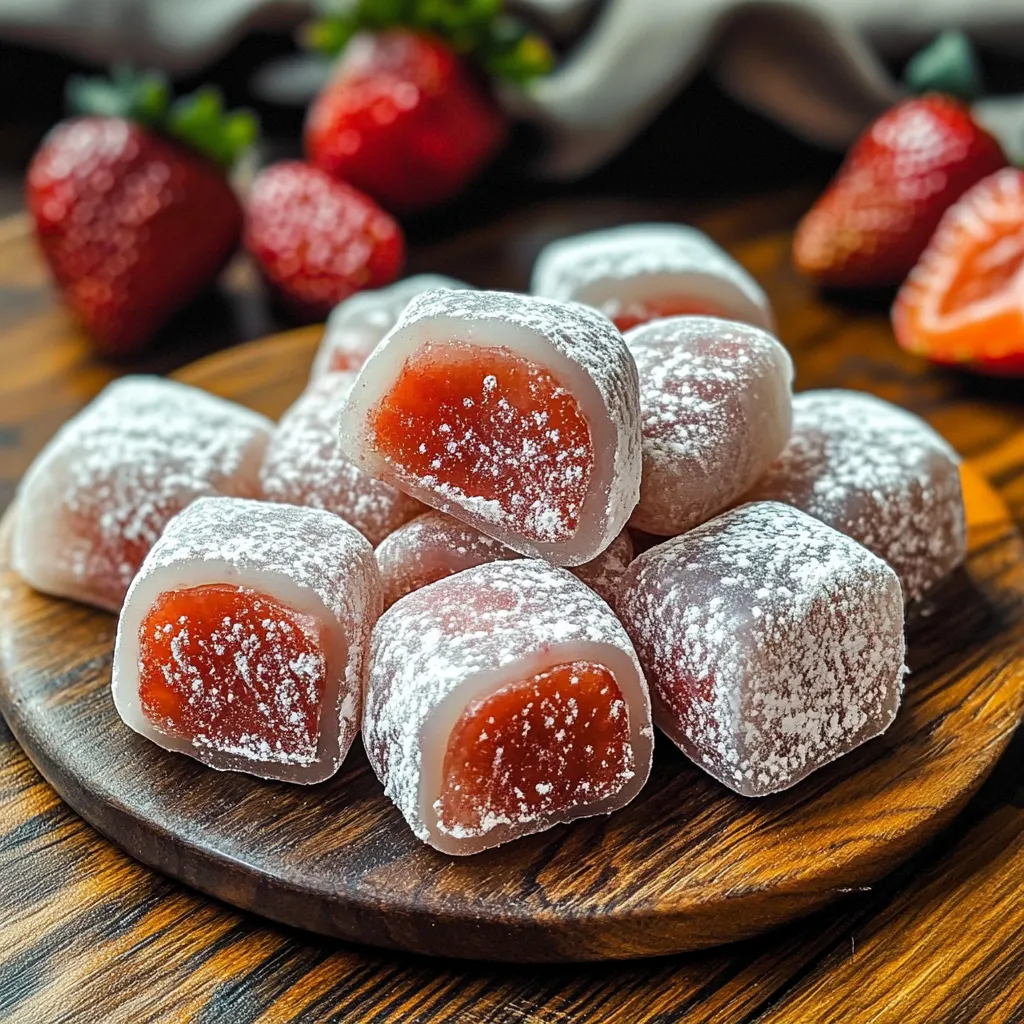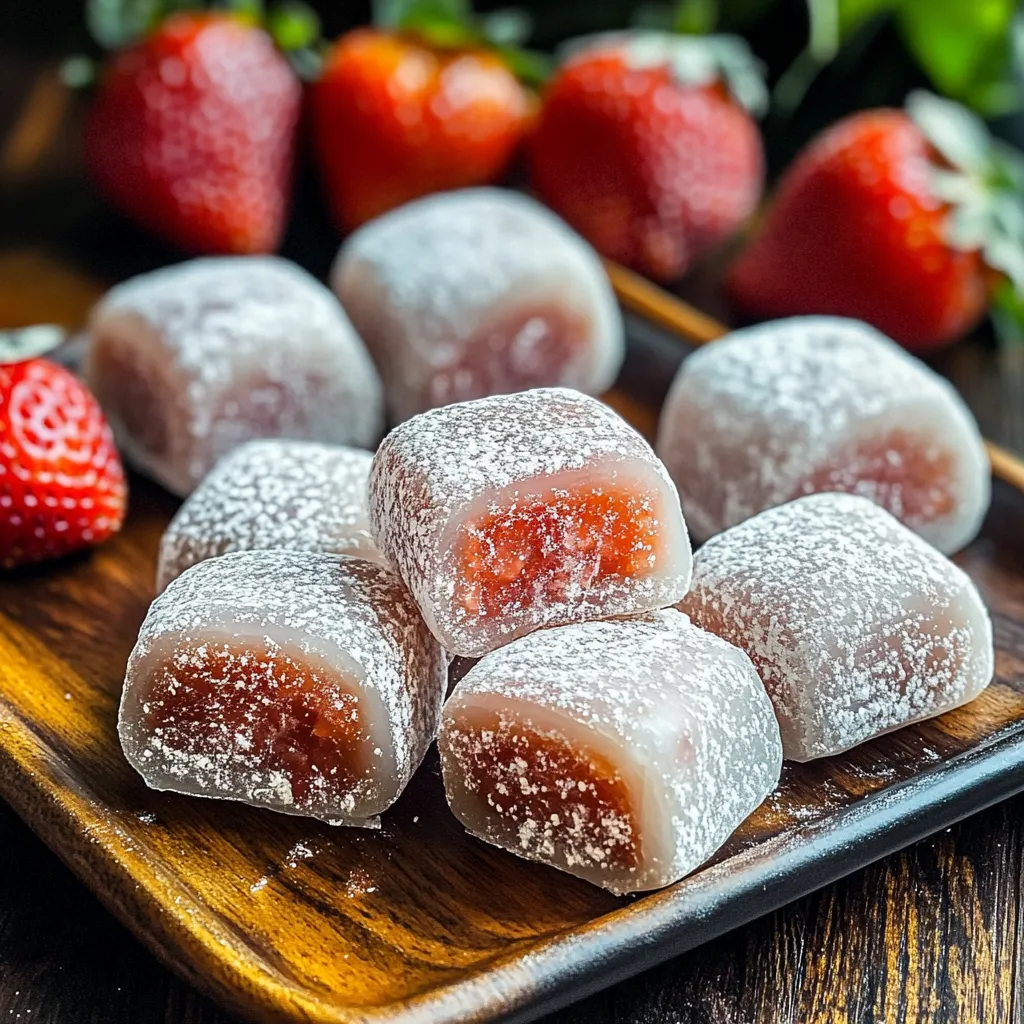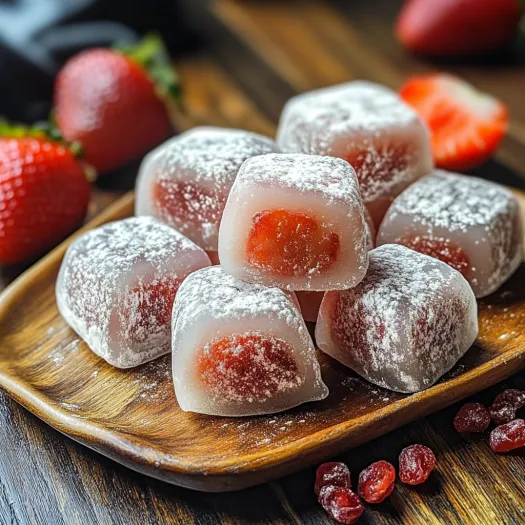 Pin it
Pin it
This delightfully chewy strawberry mochi brings authentic Japanese flavors right to your kitchen. The sweet, pillowy texture wrapped around fresh strawberries creates a beautiful contrast that makes this dessert both visually stunning and irresistibly delicious. I first tasted mochi during a trip to Japan and spent years perfecting this homemade version that rivals any I had overseas.
I originally made these for a friend's birthday who missed the authentic mochi from her childhood in Japan. She teared up after the first bite saying it transported her back home instantly. That moment solidified this recipe as my go to impressive yet simple dessert.
Ingredients
- Sweet rice flour: Also called glutinous rice flour, gives mochi its signature chewy texture. Look for Mochiko brand for best results
- Granulated sugar: Provides just enough sweetness without overpowering the strawberry
- Water: Works to activate the rice flour creating that perfect sticky consistency
- Vanilla extract: Adds a subtle warmth that complements the strawberry flavor
- Cornstarch: Prevents sticking during rolling and shaping. Do not substitute with flour
- Fresh strawberries: Should be ripe but firm. Choose bright red berries with no soft spots
- Red bean paste: Traditional Japanese anko adds authentic flavor. Find it at Asian markets or make your own
Step-by-Step Instructions
- Create the Mochi Base:
- Thoroughly mix sweet rice flour and sugar in a medium bowl until completely combined. This ensures even sweetness throughout your mochi. Pour in water and vanilla extract slowly while stirring to prevent lumps. The batter should resemble a thick pancake batter when properly mixed.
- Microwave Method:
- Transfer your batter to a microwave safe dish lined with parchment paper. The parchment prevents sticking and makes removal easier later. Cover with plastic wrap but leave a small opening for steam to escape. Microwave on high for 2 minutes, check for doneness. The mochi should appear translucent rather than opaque. If needed, microwave for additional 30 second intervals until translucent.
- Cooling and Preparation:
- Allow the mochi to cool for approximately 5 minutes; it will still be very hot directly from the microwave. Generously dust your work surface with cornstarch; this is crucial to prevent sticking. Transfer the cooked mochi to your prepared surface and dust the top as well. Handle gently as the mochi will be very sticky.
- Rolling and Cutting:
- Using a cornstarch dusted rolling pin, roll the mochi to about 1/4 inch thickness. Work quickly as mochi becomes more difficult to handle as it cools. Cut into 3 inch squares using a sharp knife or cookie cutter dusted with cornstarch. Keep extra cornstarch nearby for dusting as needed.
- Filling and Folding:
- Place a slice of strawberry and a small teaspoon of red bean paste in the center of each square. Avoid overfilling, which makes sealing difficult. Gently fold the edges over the filling, bringing opposite corners together and pinching firmly to seal. The warmth of the mochi helps it stick to itself, creating a secure pocket.
- Final Touches:
- Dust off excess cornstarch using a small pastry brush. This improves both the appearance and texture of your final mochi. Arrange on a serving plate and enjoy within 24 hours for best texture and flavor.
 Pin it
Pin it
My favorite part of this recipe is watching people experience mochi for the first time. The unique texture often surprises them but quickly becomes addictive. My daughter now requests these for special occasions instead of cake which I consider the highest compliment a recipe can receive.
Storage Tips
Mochi changes texture quite rapidly after preparation. For best results, consume within 24 hours of making. If you need to store leftovers, place in an airtight container with pieces separated by parchment paper to prevent sticking. Refrigerate for up to 2 days, but allow to come to room temperature before serving to restore some of the softness.
Seasonal Variations
While strawberries create a classic mochi filling, this versatile recipe welcomes seasonal adaptations. Try fresh peach slices in summer, mango chunks in spring, or even persimmon in fall. For winter months, consider using a small piece of dark chocolate inside each mochi with a sprinkle of cinnamon in the mochi dough. The basic mochi recipe remains unchanged; only the filling adapts to what nature provides at its peak.
Traditional Context
Mochi holds profound cultural significance in Japanese cuisine dating back centuries. Traditionally made during a ceremony called mochitsuki, where rice is pounded with wooden mallets in a mortar. This labor-intensive process brings communities together, especially during New Year celebrations. Our microwave version maintains the authentic flavor and texture while making this treasured treat accessible to home cooks without specialized equipment.
 Pin it
Pin it
Mochi is an unforgettable experience—a delightful balance of flavors and textures that's always worth the effort. Bring a little bit of Japan to your kitchen today!
Frequently Asked Questions
- → Can I use other fruits instead of strawberries?
Yes! While strawberries provide a wonderful juicy sweetness, you can substitute with other fruits like mango, peach, or blueberries. Just ensure they're ripe but firm enough to hold their shape when wrapped in the mochi.
- → What is sweet rice flour and can I substitute it?
Sweet rice flour (also called glutinous rice flour or mochiko) is essential for achieving the characteristic chewy texture. Regular rice flour or all-purpose flour won't work as substitutes as they lack the necessary starch composition that creates the signature mochi texture.
- → How long does homemade mochi stay fresh?
Freshly made mochi is best consumed within 24 hours. Store at room temperature for up to 1 day, covered with plastic wrap to prevent drying. If you need to store longer, refrigerate for up to 2-3 days, but be aware the texture will gradually become firmer.
- → Is there an alternative to microwaving the mochi dough?
Yes, you can steam the mochi mixture. Place the bowl with the batter over a pot of simmering water and cover. Steam for about 15-20 minutes, stirring occasionally until the mixture becomes translucent and sticky.
- → Can I make mochi without red bean paste?
Absolutely! The red bean paste is optional. You can use just fresh strawberries or substitute with other fillings like chocolate, Nutella, or sweetened cream cheese for a fusion twist.
- → Why is my mochi too sticky to work with?
Mochi is naturally sticky. The key is using enough cornstarch when handling it. Don't be shy with the cornstarch on your work surface, hands, and tools. If still too sticky, the dough might need more cooking time or could have too much moisture.
